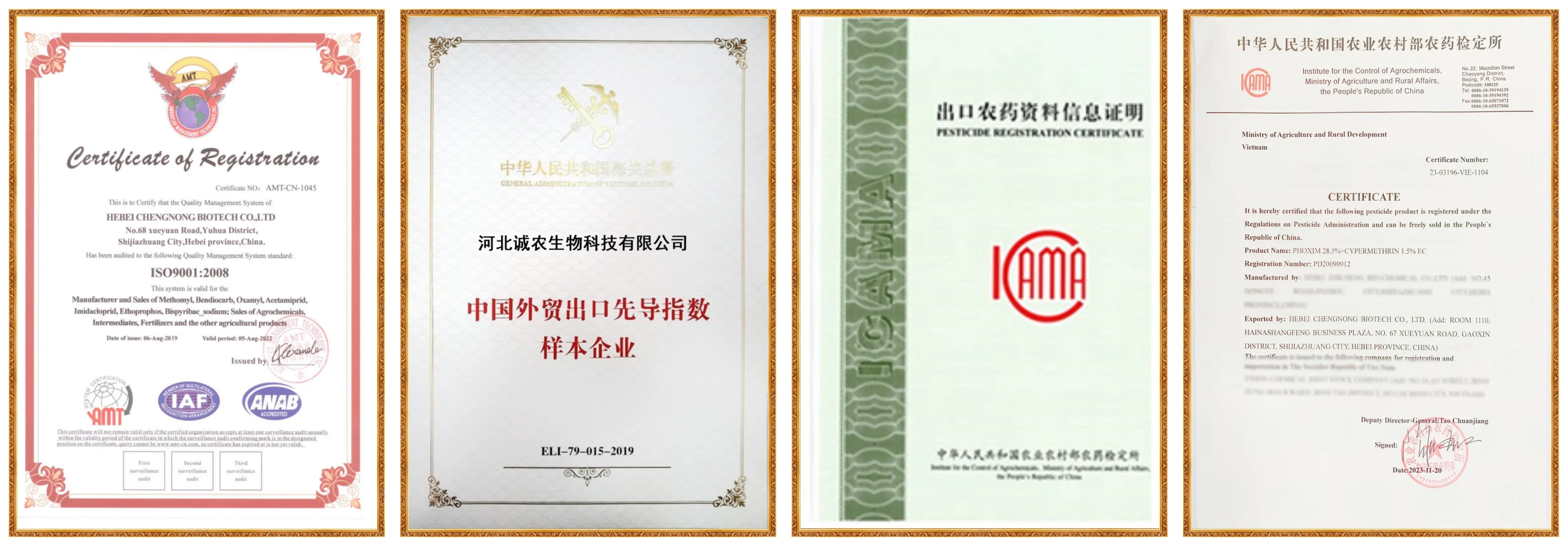
Nov . 13, 2024 05:58 Back to list
best nicosulfuron atrazine
The Best Use of Nicosulfuron and Atrazine in Agriculture
In modern agriculture, herbicides play a crucial role in ensuring high crop yields by managing weed populations. Among the various herbicides available, Nicosulfuron and Atrazine have gained significant attention due to their effectiveness in controlling a wide range of weed species. Understanding the best practices for their use can optimize crop production, promote sustainability, and ensure environmental safety.
Nicosulfuron A Systemic Herbicide
Nicosulfuron is a selective, systemic herbicide primarily used to control grass weeds in corn (Zea mays) cultivation. As a member of the sulfonylurea family, it operates by inhibiting the enzyme acetolactate synthase (ALS), which is crucial for amino acid synthesis in plants. Nicosulfuron is particularly effective against weeds like giant foxtail (Setaria faberi), crabgrass (Digitaria spp.), and yellow foxtail (Setaria pumila).
To maximize its effectiveness, Nicosulfuron should be applied when weeds are in their early growth stages, ideally when they are less than 4 inches tall. Timing is critical, as younger weeds are more susceptible to herbicides. Additionally, the application should occur under favorable weather conditions—ideally, on a warm, sunny day with mild winds to facilitate good absorption.
Atrazine A Versatile Herbicide
Atrazine is one of the most widely used herbicides in the United States, particularly for controlling broadleaf and some grassy weeds in corn and sorghum crops. As a triazine compound, Atrazine functions by inhibiting photosynthesis in susceptible plants, leading to their demise. Its residual activity makes it an excellent option for pre-emergence and post-emergence applications.
Best practices for Atrazine include applying it before weed emergence to take full advantage of its soil residual activity. When used as part of a broader weed management strategy, Atrazine can effectively suppress weed growth, allowing crops to establish themselves more efficiently. However, growers should be cautious with Atrazine's application rates and timing, as misuse can lead to environmental issues, such as water contamination.
best nicosulfuron atrazine

Combining Nicosulfuron and Atrazine
The combination of Nicosulfuron and Atrazine can yield synergistic effects, providing broader-spectrum control of weeds. When combining these two herbicides, it’s essential to consider the specific weed spectrum present, as well as the growth stage of the crop and the target weeds. This approach not only enhances weed control but also helps delay the development of herbicide-resistant weed populations.
Incorporating practices such as tank mixing and rotating herbicides can further improve the efficacy of both Nicosulfuron and Atrazine. Tank mixing allows for a more comprehensive control program, while rotation minimizes the risk of resistance development.
Environmental Considerations
While the application of Nicosulfuron and Atrazine can be highly effective, it is crucial to adhere to environmental guidelines to mitigate potential risks. Implementing practices such as buffer zones near water bodies, proper calibration of application equipment, and adhering to recommended application rates can significantly decrease the likelihood of herbicide runoff and contamination.
Conclusion
In conclusion, the effective use of Nicosulfuron and Atrazine can enhance weed management in corn and sorghum cultivation. By adhering to best practices—timing, application methods, and environmental safeguards—farmers can optimize their crop yields while promoting sustainable agricultural practices. As agriculture continues to evolve, the responsible use of these herbicides will remain crucial for food security and environmental health.
-
Azoxystrobin Fungicide: Advanced Crop Protection Solutions
NewsAug.22,2025
-
Willowood Imidacloprid: Best Broad-Spectrum Insecticide Solution
NewsAug.22,2025
-
Atrazine Herbicide: Selective & Effective Weed Control for Sale
NewsAug.21,2025
-
Azoxystrobin: Broad-Spectrum Fungicide Solutions
NewsAug.11,2025
-
Best EPA Boscalid: Superior Crop Fungicide for Max Yields
NewsAug.11,2025
-
Best Willowood Imidacloprid: Superior Pest Control Solutions
NewsAug.10,2025
